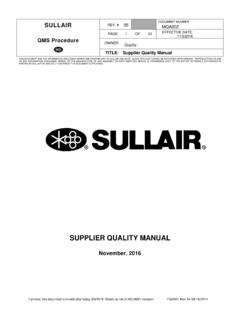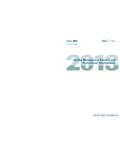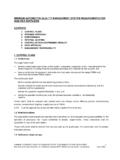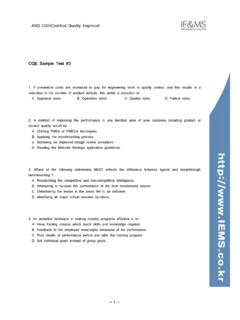Transcription of CQI-8 - best9000.com
1 CQI-8 Layered Process Audits Guideline Layered Process Audits CQI-8 1 Issue: Dated: 12/2005 Replaces: N/A Dated: N/A AIAG PUBLICATIONS An AIAG publication reflects a consensus of those substantially concerned with its scope and provisions. An AIAG publication is intended as a guide to aid the manufacturer, the consumer and the general public. The existence of an AIAG publication does not in any respect preclude anyone from manufacturing, marketing, purchasing, or using products, processes, or procedures not conforming to the publication. CAUTIONARY NOTICE AIAG publications are subject to periodic review and users are cautioned to obtain the latest editions. MAINTENANCE PROCEDURE Recognizing that this AIAG publication may not cover all circumstances, AIAG has established a maintenance procedure.
2 Please refer to the Maintenance Request Form at the back of this document to submit a request. APPROVAL STATUS The quality Requirements Task Force and designated stakeholders approved this document for publication on November 9, 2005. Published by: Automotive Industry Action Group 26200 Lahser Road, Suite 200 Southfield, Michigan 48034 Phone: (248) 358-3570 Fax: (248) 358-3253 AIAG Copyright and Trademark Notice: The contents of all published materials are copyrighted by the Automotive Industry Action Group unless otherwise indicated. Copyright is not claimed as to any part of an original work prepared by a or state government officer or employee as part of the person s official duties. All rights are preserved by AIAG, and content may not be altered or disseminated, published, or transferred in part of such content.
3 The information is not to be sold in part or whole to anyone within your organization or to another company. Copyright infringement is a violation of federal law subject to criminal and civil penalties. AIAG and the Automotive Industry Action Group are registered service marks of the Automotive Industry Action Group. 2005 Automotive Industry Action Group Layered Process Audits CQI-8 2 Issue: Dated: 12/2005 Replaces: N/A Dated: N/A FOREWORD Industry data show that most manufacturing quality issues are caused by poor process control or by a failure to follow the appropriate process instructions. Effective management of process capability requires the identification of sources of both special and common cause variation. Once the sources are identified, corrective actions designed to address them must be effectively implemented and sustained.
4 Employees do not refer to instructions or procedures before every step of a process; they often complete the processes by memory, which comes from repeating and practicing each step many times over. Once necessary process changes are identified, employees must re-learn and adjust. However, it is very easy for employees to return to the old, familiar methods. Before 2005, DaimlerChrysler and General Motors required different process review approaches, including different approaches for Layered Process Audits. It was recognized that the Layered Process Audit methodology was not unique to any particular company, hence, under the auspices of the AIAG, DaimlerChrysler and General Motors developed a common approach for Layered Process Audits. One of the principal purposes of industry standard practices is to address commonly observed issues that are not isolated to any one company, commodity, or process within the industry.
5 Validation of process improvements and corrective actions is one commonly observed industry issue that can be directly improved by the use of Layered Process Audits, which are designed for this specific purpose. Layered Process Audits require that multiple operational levels within a manufacturing facility review the same key operational controls that ensure product quality . Controlling quality at multiple operational levels is a key strength of Layered Process Audits. Layered Process Audits CQI-8 3 Issue: Dated: 12/2005 ACKNOWLEDGEMENTS The following individuals were actively involved in the development of this Guideline. Name Company Jeanine Grimaudo DaimlerChrysler Corporation Jerod Long General Motors Corporation The Layered Process Audit team gratefully acknowledges the leadership and commitment of Vice Presidents Peter Rosenfeld at DaimlerChrysler Corporation and Bo Andersson of General Motors Corporation as well as the assistance of the AIAG in developing, producing, and distributing this Guideline.
6 Replaces: N/A Dated: N/A Layered Process Audits CQI-8 4 Issue: Dated: 12/2005 Replaces: N/A Dated: N/A TABLE OF CONTENTS LAYERED PROCESS AUDITS AIAG CAUTIONARY MAINTENANCE APPROVAL PURPOSE OF THIS WHAT ARE LAYERED PROCESS AUDITS?..7 TYPICAL STEPS FOR DEVELOPING AND IMPLEMENTING LAYERED PROCESS SCOPE OF USE OF LAYERED PROCESS THE BENEFITS OF LAYERED PROCESS EVERYONE IS AN "AUDITOR" ..9 LAYERED PROCESS AUDITS AND THE "IS / IS NOT" LAYERED PROCESS AUDITS ARE: ..10 LAYERED PROCESS AUDITS ARE NOT: ..10 GUIDANCE FOR PLANNING LAYERED PROCESS AUDIT AUDIT AUDIT AUDIT NON-CONFORMANCE AUDIT CONDUCTING LAYERED PROCESS DISCIPLINE IN CONDUCTING RECORDING WHEN A NON-CONFORMANCE IS CORRECTIVE ACTION REVIEWING LAYERED PROCESS AUDIT MAINTAINING LAYERED PROCESS MANAGING THE ITEMS ON A LAYERED PROCESS Adding or Changing Layered Process Audit Deleting Layered Process Audit ADDING CORRECTIVE ACTIONS TO LAYERED PROCESS AUDITING COMPLIANCE TO LAYERED PROCESS AUDIT ABOUT Layered Process Audits CQI-8 5 Issue: Dated: 12/2005 Replaces: N/A Dated: N/A PURPOSE CORE AIAG AIAG MAINTENANCE Tables TABLE 1A.
7 TYPICAL STEPS FOR DEVELOPING AND IMPLEMENTING TABLE 1B. HOW TO EXPLAIN LAYERED PROCESS AUDITS TO TABLE 2A. EXAMPLE OF AN OPERATION-FOCUSED LAYERED PROCESS AUDIT TABLE 2B. EXAMPLE OF A LAYERED PROCESS AUDIT PLAN SHOWING AUDIT AREAS (ADDITIONAL AREAS FOR HIGHER LEVELS OF EACH LAYER), AUDIT LAYERS, AND AUDIT TABLE 5. EXAMPLE OF AUDITING COMPLIANCE TO LAYERED PROCESS AUDIT Figures FIGURE 2. EXAMPLE OF A LAYER-FREQUENCY LAYERED PROCESS AUDIT FIGURE OF LAYERED PROCESS AUDIT RESULTS SUMMARIZING PLANNED VS. ACTUAL LAYERED PROCESS AUDITS BY MANAGEMENT LEVEL AND FIGURE OF LAYERED PROCESS AUDIT RESULTS PERCENT OF AUDITED ITEMS IN Layered Process Audits CQI-8 6 Issue: Dated: 12/2005 Replaces: N/A Dated: N/A INTRODUCTION Background Industry data show that most manufacturing quality issues are caused by poor process control--often a failure to reinforce manufacturing process corrective actions or a failure to follow the required process steps.
8 Effective management of process compliance requires the identification of sources of both special and common cause variation. Examples of special cause variation might include failure of one shift of personnel to follow the prescribed process. Examples of common cause variation might include an inadequate FMEA for the manufacturing process. Once the sources are identified, the corrective actions designed to address them must be effectively implemented and sustained. Employees typically do not refer to instructions or procedures before every step of a process; they often complete the processes by memory, which comes from repeating and practicing each step many times over. Once necessary process changes are identified, employees must re-learn and adjust. It is very easy for them to return to the old, familiar methods.
9 There might even be perceived incentives in place to follow the "tried and true" previous processes, even though studies have shown that the "tried and true" processes were not adequate to meet customer requirements. Purpose of This Guideline Layered Process Audits reduce variation along the manufacturing line and up through the ranks of plant management. However, if each customer (OEM) developed its own Layered Process Audit method, the effectiveness overall would be reduced. The basic approach for the Audits is an established concept; therefore, there is no competitive advantage for any particular OEM to develop a custom approach. The competitive advantage, though, could lie in the chosen application of the common Audit approach. The concepts behind Layered Process Audits are not new.
10 They find their origin in the well-known Plan-Do-Check-Act continuous improvement cycle. This Guideline is not designed to introduce any significant improvements in the technology or application methodology of Layered Process Audits. It is designed to provide a common framework of the definitions and standard approaches that can be adopted by any automotive OEM or supplier to an OEM (tier 1), at any depth in the supply chain (any tier). Each organization may choose to develop specific requirements for Layered Process Audits, for example, the frequency of the audits or the minimum topics to be included in the question sets. Such specific requirements will augment the suggested framework defined by this Guideline. Layered Process Audits CQI-8 7 Issue: Dated: 12/2005 Replaces: N/A Dated: N/A WHAT ARE LAYERED PROCESS AUDITS?





